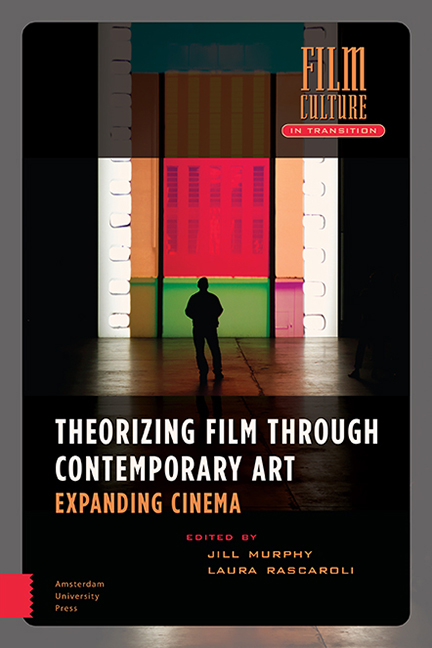Book contents
- Frontmater
- Dedication
- Contents
- List of Illustrations
- Acknowledgments
- Foreword: Courtesy of the Artists
- Introduction: On Cinema Expanding
- Part One Materialities
- 1 Cinema as (In)Visible Object; Looking, Making, and Remaking
- 2 Objects in Time; Artefacts in Artists’ Moving Image
- 3 Materializing the Body of the Actor; Labour, Memory, and Storage
- 4 How to Spell ‘Film’; Gibson + Recoder’s Alphabet of Projection
- Part Two Immaterialities
- 5 The Magic of Shadows; Distancing and Exposure in William Kentridge’s More Sweetly Play the Dance
- 6 Douglas Gordon and the Gallery of the Mind
- 7 A Throw of the Dice Will Never Abolish Chance; Tacita Dean’s Section Cinema (Homage to Marcel Broodthaers)
- Part Three Temporalities
- 8 The Photo-Filmic Diorama
- 9 The Cinematic Dispositif and Its Ghost; Sugimoto’s Theaters
- 10 Time/Frame: On Cinematic Duration
- Part Four The Futures of the Image
- 11 Interactivity without Control; David OReilly’s Everything (2017) and the Representation of Totality
- 12 Post-Cinematic Unframing
- 13 Absolute Immanence
- Index
Introduction: On Cinema Expanding
Published online by Cambridge University Press: 23 June 2021
- Frontmater
- Dedication
- Contents
- List of Illustrations
- Acknowledgments
- Foreword: Courtesy of the Artists
- Introduction: On Cinema Expanding
- Part One Materialities
- 1 Cinema as (In)Visible Object; Looking, Making, and Remaking
- 2 Objects in Time; Artefacts in Artists’ Moving Image
- 3 Materializing the Body of the Actor; Labour, Memory, and Storage
- 4 How to Spell ‘Film’; Gibson + Recoder’s Alphabet of Projection
- Part Two Immaterialities
- 5 The Magic of Shadows; Distancing and Exposure in William Kentridge’s More Sweetly Play the Dance
- 6 Douglas Gordon and the Gallery of the Mind
- 7 A Throw of the Dice Will Never Abolish Chance; Tacita Dean’s Section Cinema (Homage to Marcel Broodthaers)
- Part Three Temporalities
- 8 The Photo-Filmic Diorama
- 9 The Cinematic Dispositif and Its Ghost; Sugimoto’s Theaters
- 10 Time/Frame: On Cinematic Duration
- Part Four The Futures of the Image
- 11 Interactivity without Control; David OReilly’s Everything (2017) and the Representation of Totality
- 12 Post-Cinematic Unframing
- 13 Absolute Immanence
- Index
Summary
This book is born of a visit to an exhibition. We saw Philippe Parreno's Hypothesis at the Pirelli HangarBicocca of Milan in December 2015. A complex, anthological ‘choreography’ including many works and collaborations by the artist, Hypothesis is a deeply cinematic work. The term cinematic, albeit frequently used, requires qualification. While recognizing that it is resistant to definition, Maeve Connolly has explored a range of ways in which it has been used by critics to discuss art that has to do with the activities, materialities, and processes of filmmaking, while being ‘located outside or beyond cinema’. In line with this definition, although including a number of films and videos, the cinematicity of Parreno's Hypothesis exists outside and beyond them (and even above them, given that much in his exhibition happens at hangar-ceiling height). But what is significant about our experience of Parreno's exhibition, and generated the reflection at the root of this volume, is that Hypothesis struck us as a cinematic artwork that is theoretical. That is, a work that is not only associated with, and draws on, the cinema as imagery, medium, and cultural referent, but one that functions as a theory of it. The whole set up, indeed, powerfully spoke to us not only through, but also of the cinema – seen as a specific, historicized experience, as a constructed space, a set of cultural meanings, and an apparatus. Ideas of film technology, projection, reproduction, spectatorship, narrativity, temporality, historicity, and myth all came to us as if in waves while we explored the vast expanse of the gallery, formerly an industrial hangar. Concrete objects of the cinema (spotlights, marquees, sets, rails, screens, projectors) as well as immaterial ones (the play of light and shadows, the identifications, the mythology) were at the basis of this effect, while not exhausting it.
It is of course possible to identify the cinema as an inspiration behind discrete works in Hypothesis. The rather overpowering installation Danny the Street (2006–2015), for instance, is composed of nineteen differently shaped and sized marquees – sculptures in Plexiglas and lightbulbs which, positioned at different heights, form an imaginary, almost sentient avenue under which the visitor walks
- Type
- Chapter
- Information
- Theorizing Film Through Contemporary ArtExpanding Cinema, pp. 33 - 46Publisher: Amsterdam University PressPrint publication year: 2020



